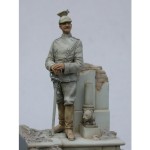
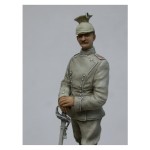
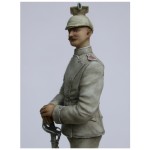

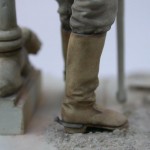
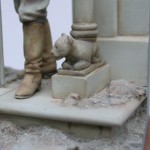
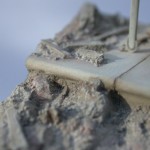
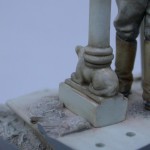
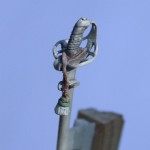
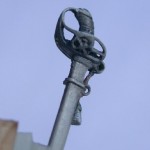

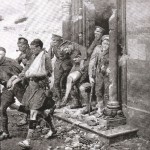
Prussian Trooper, Kings Uhlan Regt. No. 13 (1. Hanoverian), Western Front, 1914
- Scale / Maßstab: 54mm
- Material: Resin, Model Plaster / Modell-Gips (synethetische, kunststoffveredelte Gießmasse)
- Parts / Teile: 12
- Infosheet / Infoblatt: English
- Code: 18KU
Contents / Inhalt:
- Figure (6 parts) / Figur (6 Teile)
- Alternative Head with Field Cap / Alternativ-Kopf mit Feldmütze M1910
- Cavalry Pattern Sword M1889 / Kavallerie-Degen M1889
- Emblem
Model Plaster / Modell-Gips:
- Base / Sockel
- Wall / Wand
- Pillar / Säule
Extracts from the Infosheet with this figure:
The figure depicts a young trooper from one of the Prussian Lancer line regiments in the opening months of the Great War. The Lancer, or Uhlan regiments derived from the old Prussian Towarcys units, with their strong Polish – Bosnian links and armed with the lance were primarily used for foraging and scouting duties in East Prussia. The Kings Uhlan Regt. No. 13 (1st Hanoverian) was formed in 1889 and garrisoned in Hanover, Lower Saxony. The regiment belonged to the X Army Corp and Colonel-in-Chief was the German Kaiser.
The Heads
Head 1: A man in his early twenties with the typical, fashionable moustache of the time. He wears his lancer Tschapka helmet with a slight tilt to one side. Regulations stated that the Tschapska should be worn with the visor 3 cm over the right eyebrow and 5 cm over the left. Colour: the helmet without the cover – black leather, with brass rim edges (can only be seen where the cover has slipped up at the front). Cover – rush-green (in practice these covers would fade within a short time and the result was a light beige, or grey colour).
Head 2: This is a younger trooper wearing the field cap, his face grinning with pride, as he stands amongst the ruins of a church entrance somewhere between Le Cateau and Landrecies only hours after British troops have evacuated the town. The late summer months in the opening stages of the war were particularly warm, dry and like many of his comrades his hair has been cropped short.
Uniform
Lancer Helmet M1889/94 / Tschapka M1889/94: The typical lancer helmet of the period with similar designs in most other European armies at the time. Made out of lacquered, blackened leather with a small visor at the front of the helmet, which was decorated in the same button colour metal. On the right hand corner of the flat top – or mortar-board was the attachment leather toggle (on some helmets a hook) to which the cap line – Fangschnur – would be fixed. The cap line would not normally be worn with field dress. The chin- strap on the helmet is underneath the cover – the outlines can just be made out on the figure’s helmet. In the field these helmets were protected with a reed green cotton cover, with slits for the toggle and cockade. At the rear of the cover was a rubber cord to ensure a good fit.
The long cockade, or Feldzeichnen was made from wood with a cloth cover and positioned at the front left angle of the mortar-board. All Prussian regiments had black and white cockades (officers had silver cord instead of white). The reverse of the cockade was black and when fixed to the helmet would sometimes tilt inwards, underneath the board.
Ulanka M1908: The field grey Ulanka M1908 was the traditional tunic worn by the Uhlans in the Great War. At the front, the breast garment, or plastron had a row of 6 buttons (Neusilber or Tombak – depending on regiment) at each side and opened only on the right. The pear-shaped shoulder straps on the field grey Ulanka were in contrast to the peacetime variants generally disliked by the troops and earned the name of “fly-swats”. They were too short in length, lost their shape and appearance (the piping would wear-off) and in the main regarded as “unmilitary”. The tunics were piped in the facing colour of the relevant regiment around the outer edge of the stand-up collar, shoulder straps, breast garment, along the back and sleeve seams, around the rear vents, the Polish style cuffs and the bottom edge. Regiment numbers or cyphers would be on each of the shoulder straps – normally in red.
On the Ulanka itself, the structure and fold of the creases follows the standard form copied from various photos of Ulans in the field. It is always better when gathering reference material to use original photos of troops who have been actually wearing their uniforms over long periods of time, as most garments (as indeed all types of clothing, depending on the material used) will crease and fold in roughly the same way. Some reference books, especially for collectors of uniforms are helpful for colour-reference and information etc., but will not always portray an accurate picture of how the uniforms appeared after many days of being worn.
Cavalry Breeches M1908 / Reithosen M1908: Made out of a field grey material and normally would not have the piping on the sides of the breeches. The extra inside leg material, or booting was also of a grey colour, but could occasionally have a green-grey tone.
Cavalry Boots / Kavalleriestiefel: The cavalry boot was made out of a light brown leather, with the shaft reaching up to just below the knee and slanting back 6 –7 cm to the rear. The creases around the lower leg and ankels have been copied from the original items, incl. photos from this period, which seem to follow roughly the same pattern. Colour: at the beginning of the war the boots had a natural light tan, which was then often darkened by coats of dubbin. From late 1915 onwards, boots and other leather equipment in the German Army were issued blackened.
Spurs / Anschlagsporen: With the issued cavalry boot belonged the rowel spurs for NCOs and other ranks in all mounted units (except in Bavarian units, which used the buckle-on version). These were made out of iron or plated steel and had a mandrel or spike, which was hammered into the back heel of the boot, along with the two arms nailed on each side. The spur had a small spiked wheel at the end of a slightly curved neck.
Weapon
Cavalry Pattern Sword M1889 / Kavallerie-Degen M1889: Apart from a few exceptions this was the standard sword of the cavalry carried by NCOs and troopers. The main characteristics being a long straight weapon used for thrusting rather than cutting. The knuckle-bow (hilt) made out of steel incorporated the national emblem of the contingent, or State – in this case the Prussian eagle. The grip (handle) was in a black hard rubber, with 2 metal screws holding them in place. Note: with a bit of care and a thin, sharp blade it is possible to hollow out the gaps between the grip and the hilt. Here the resin has been cast extra thin. Also, within the hilt itself and inside the locket (small ring for attaching sword to belt) are areas of thin resin, which can be hollowed out. These can best be seen by holding the item in front of a light.
Sword-Knot / Faustriemen: Attached to the handle and hanging down one side of the sword behind the locket is the sword knot. Originally used to avoid the loss of the weapon in combat, i.e. attached to soldier’s wrist, but later taking on a more ceremonial role enabling the rank and squadron to be identified. The knot was comprised of 4 parts: strap Riemen – light brown or red-brown leather, slide Schieber – plaited light or red – brown leather, crown Kranz – see table below and tassel Fransen – white.
Miscellaneous
The Base: The base supplied with the figure depicts part of a Gothic church archway damaged through artillery fire in a small town, close to the fighting between Le Cateau and Landrecies in northern France. The bricks, plaster, pieces of timber from the old wooden door and part of the roof are heaped around the steps. Parts of one of the concrete door pillars are lying smashed in front and the whole area is covered in plaster and brick dust.
 An deutschsprachige Interessenten:
Sie können mich per eMail oder Telefon auch gerne auf deutsch kontaktieren. Ortsbesuch ist nach Absprache möglich.
An deutschsprachige Interessenten:
Sie können mich per eMail oder Telefon auch gerne auf deutsch kontaktieren. Ortsbesuch ist nach Absprache möglich.
